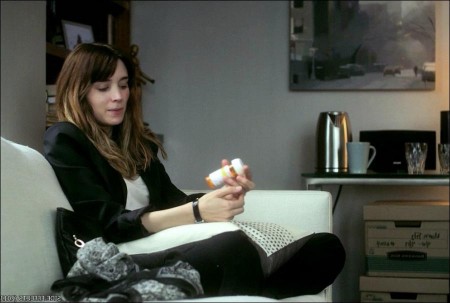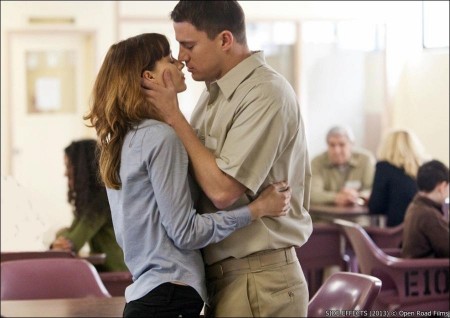Taglines: One pill can change your life.
”Side Effects” is a provocative thriller about Emily and Martin (Rooney Mara and Channing Tatum), a successful New York couple whose world unravels when a new drug prescribed by Emily’s psychiatrist (Jude Law) – intended to treat anxiety – has unexpected side effects.
Emily (Academy Award nominee Rooney Mara) and Martin Taylor (Channing Tatum) are a young, beautiful, wealthy couple living the good life, with a mansion, a sailboat and every luxury money can buy—until Martin is sent to prison for insider trading. For four years, Emily waits for him in a tiny apartment in upper Manhattan, but his release is just as devastating as his incarceration and Emily sinks into a deep depression.
After a failed suicide attempt, psychiatrist Jonathan Banks (Academy Award nominee Jude Law) is called in to consult on Emily’s case. Desperate not to be hospitalized, Emily agrees to a regimen of therapy and antidepressants, a decision that will change the lives of everyone involved. When Emily’s symptoms don’t improve, Banks prescribes a new medication that quiets her demons.
But the side effects of the drug have chilling consequences: marriages are ruined, Banks’ practice is decimated and someone is dead—but who is responsible? Devastated by this professional setback, Banks becomes obsessed with finding an answer. But the truth he uncovers threatens to destroy whatever is left of his career and his private life.
About the Production (2013)
Over a decade ago screenwriter Scott Z. Burns spent several weeks doing research at New York’s famed Bellevue Hospital psychiatric facility. Burns, who was then writing for the acclaimed television medical drama Wonderland, spoke with the psychiatrists on staff and watched them at work with mentally ill patients, including many who had a criminal past.
“It was one of the most extraordinary experiences of my life,” says Burns. “There were people there who were truly terrifying criminals. There were also people who were so ill they were unable to understand the rules of society and couldn’t possibly be expected to play by them.”
The experience planted a seed in Burns’ imagination. “I wanted to write a noir-style thriller that took the audience in and spun it around, like Double Indemnity or Body Heat, set in the world of psychopharmacology,” says Burns. “I was inspired by films that involve crafty, clever scams, set against the society the audience is really living in. People seem to have stopped making those, but I have always loved the genre.”
Bardey too had always been intrigued by the idea of a thriller involving psychiatry. “Once we came up with the backbone of this story, Scott did the writing, and I provided the context.”
The combination of Burns’ prodigious storytelling skills and Bardey’s expertise resulted in an eye-opening thriller. “It looks at the idea of where reality ends and mental illness begins,” says Bardey. “You don’t know if things are what they appear to be. In that sense, it’s got a Hitchcockian feel to it. And the ending is fantastic, a great lesson and a lot of fun.”
As he constructed his narrative, Burns also conducted extensive research on the growing use of anti-depressants in this country with the help of Dr. Bardey, who ultimately served as on-set adviser and co-producer.
Burns found evidence in the news stories of the day that the same medications used to treat depression, anxiety and other psychological ailments were also creating inexplicable behavior in a small but significant number of patients. Commonly prescribed drugs were being blamed for crimes ranging from vehicular homicide to physical assault. A man in California was acquitted of charges in a non-injury vehicular accident while under the influence of a popular sleep remedy.
One widely prescribed antidepressant was even implicated in a shocking kidnapping and rape. Just as fascinating to Burns were stories he uncovered about the misbehavior of respected doctors. “There was a story in the news about a psychiatrist who tried to hire one of his patients, a convicted criminal, to kill his mistress,” says Burns. “When the patient went to the police, they didn’t believe him because he’s obviously a crazy person. Our story is completely different than that one, but it’s full of plot twists and turns that have you constantly questioning what actually happened and who is telling the truth.”
Producer Gregory Jacobs, who also worked with Soderbergh and Burns on The Informant! and Contagion, notes that Side Effects is perhaps the first thriller set in this milieu. “I hadn’t seen anybody do something about the drug industry or the prevalence of antidepressants and anti-anxiety medication in our society,” he says. “At the same time, it’s just such an entertaining thriller.”
As his script continued to evolve, Burns turned to a pair of trusted collaborators: Academy Award-winning filmmaker Steven Soderbergh and producer Lorenzo di Bonaventura. “Lorenzo hired me to write The Informant! for Warner Bros. at a time when I wasn’t qualified to lead a tour at Warner Bros.,” says Burns. “But he trusted me and believed in me. He had just started his production company, so I called him first. He was there when the movie had no home. He was open to casting ideas. This is a man who has made some giant movies, but he just loves filmmaking and he wants to make a lot of different kinds of movies.”
Di Bonaventura threw his full support behind the project. “I loved the idea of making an authentic thriller,” he says. “Hollywood has sort of abandoned the genre, so this is somewhat different in the marketplace. We developed it together. Scott wrote I don’t know how many drafts, but he always stayed true to his original vision. It was a long road, but a fun one.”
Over the period he was writing Side Effects, Burns worked with Soderbergh on The Informant! and Contagion, as well as PU-239, which Burns wrote and directed, and Soderbergh executive produced. He shared the script with Soderbergh as it developed and the director closely followed his progress.
“Scott is very adept at identifying interesting issues and wrapping them in a commercial skin,” Soderbergh says. “I like movies that try to do more than one thing at a time. Like Contagion, Side Effects can be described as a thriller, but both have an undercurrent of reality that reflects the contemporary world. If you can do that gracefully, the audience always appreciates it.”
Soderbergh says Burns is also very good at what he calls the “mathematics of a story.” “How many elements need to be in play? How you can play off the audience’s expectations? How do you navigate your way around clichés? He’s very good at the architecture, as well as creating intriguing characters and writing great dialogue.”
Burns had always planned to direct Side Effects himself, but when Soderbergh asked if he could direct, it didn’t take the screenwriter long to agree. “Steven had a window and Side Effects was the film he was most interested in making,” Burns recalls. “We had a very similar take on the material. It was hard to make an argument for me doing it, other than my ego, which is not a great place from which to make artistic decisions. I thought, if there were two minutes left in the game and either I could play quarterback or Drew Brees could play quarterback, what would be better for the team?”
Di Bonaventura also gave a thumbs up to the change in plans. “Steven brings a singular perspective to whatever he does,” the producer says. “He makes each movie feel unique, with its own set of strengths. And his sets are great to work on. They’re really professionally run and surprisingly quiet, which gives actors the room to do what they do.”
Burns and Soderbergh had already proven themselves a winning team on The Informant! and Contagion, adds the producer. “They are a good match. Steven’s films always include some kind of social commentary. This story is built on the underlying notion that we don’t really know what these medications are doing to us, but our society has come to rely on them. We leave it to the viewer to decide if it’s good or bad in the end.”
That’s just one of the questions audiences are confronted with in Side Effects, a tightly plotted thriller rife with moral ambiguity and human frailty. “I believe that what draws you into a thriller is humanity,” says Burns. “You get twisted around as much by your own heart and your own perception as by the plot mechanics. It’s great to pull the rug out from people and I think that’s a really fun thing that can happen in a movie theater. But what Steven and I wanted, beyond that, was for audiences to have the rug pulled out from under them in terms of their own experiences.”
The movie is intended to pack a one-two punch that will first entertain and then spark a discussion. “We hope that the audience will come out of the theater saying, I didn’t see that coming,” says di Bonaventura. “And then we hope they’ll realize how deeply the issue of pharmaceuticals has permeated our society.”
Side Effects (2013)
Directed by: Steven Soderbergh
Starring: Channing Tatum, Rooney Mara, Jude Law, Catherine Zeta-Jones, Mamie Gummer
Screenplay by: Scott Z. Burns
Production Design by: Howard Cummings
Cinematography by: Steven Soderbergh
Film Editing by: Steven Soderbergh
Costume Design by: Susan Lyall
Set Decoration by: Rena DeAngelo
Music by: Thomas Newman
MPAA Rating: R for sexuality, nudity, violence and language.
Studio: Open Road Films
Release Date: February 8, 2013
Visits: 492







